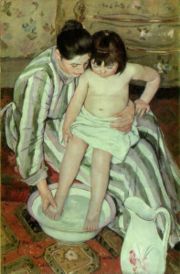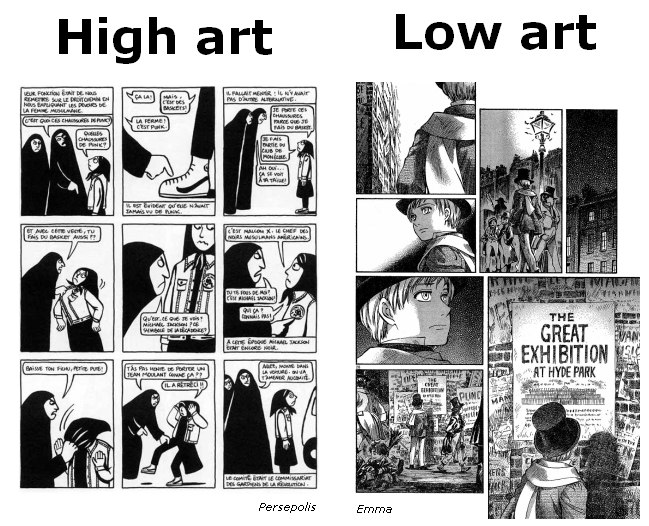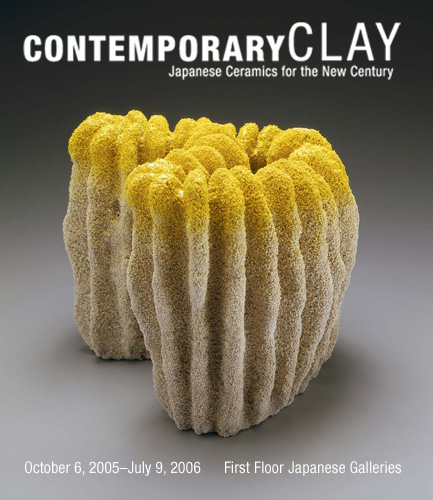The definition of "art" on Wikipedia is probably the single most consistently awful paragraph on the entire website. It is rewritten about once a month, as if the definition of art were going through time-lapse life cycles. What goes up there is hardly ever enlightening. As of April 2007, the definition talks about "aesthetic value", "various purposes", and "subjective boundaries". Just conjures up an image in your head, doesn't it? When you read it today it will probably say something entirely different. The picture is also always changing, because everyone has their favorite piece of artwork that represents all art ever. Right now (April) it is Giorgio de Chirico's Love Song, a lovely example of Surrealism but probably not the end-all of art. Clueless passers-by are constantly switching in the Mona Lisa, a painting so endlessly reproduced it is less an example of art than a symbol for "WARNING: Here Be Art", like a little stick figure indicates a restroom behind the door.
Anyway, sometime last year one Julie Martello decided she could make the article better. And indeed she did. She wrote this lead, and accompanying it was Mary Cassat's The Bath, probably the single most representative picture to exemplify both Western and global visions of art:
- Art is the word we use when we refer to that creative activity or its result, when images and objects, sights and sounds, drawings and carvings, convey the beauty and splendor of the world, or realize the imagination of the artist, for the purpose of self-expression or the shared enjoyment of its creation. Art is that which elevates our interpretation of the world and of ourselves from mere description or narrative, to the sublime.
This is a work of brilliance that propelled Wikipedia far beyond Britannica as an authority on art. It is both entirely accurate and difficult for habitual complainers to argue with. Of course, after a couple of weeks it was rewritten from scratch.
Here at Everything Shii Knows, though, Ms. Martello's summary lives! As long as I am alive I will host that paragraph here, unchanged, so that anyone who thinks "what is art?" is a stodgy intellectual question can drop by this page and get an unexpected breath of fresh air. There are no other users on this wiki to screw it up for everyone else. Just me, and you have my pledge.
Contents |
The sad story of art
- Because works of art are reproducible, they can, theoretically, be used by anybody. Yet mostly -- in art-books, magazines, films, or within gilt frames in living-rooms -- reproductions are still used to bolster the illusion that nothing has changed, that art, with its unique undiminished authority, still justifies other forms of authority, that art makes inequality seem noble and hierarchies seem thrilling. For example, the whole concept of the National Cultural Heritage exploits the authority of art to justify the present social system and its priorities.
- John Berger, Ways of Seeing. p. 29
Much of modern art is a futile attempt at demolishing this mutual understanding.
Below this line the article is no longer up to date and does not represent my "valid opinion" as it currently stands.
You're still welcome to read it. Just thought I'd let you know.
Literature is also art
Consult Ms. Martello's lead and you will find that literature technically fits into the realm of art. Scott McCloud has a figure he likes to use to show the overlap of comic books: a triangle with corners representing realism, symbolism, and abstraction. Words are in the triangle as well as drawings. This is a little tangential to my point, though, which is that words are a sort of specific art with stronger constraints. A picture says a thousand words, but which thousand words? Two people can be affected very differently by Guernica. When it is put in writing, though ("A scene shows a horse crying out in pain, contorted..."), usually you know exactly what the intention is, although good writers will often make the meaning of the story a puzzle you have to read closely to enjoy.
"High art" and "low art"
The mainstream media have an annoying tendency to treat certain kinds of art as "high art," worthy of review and criticism, and the rest as "low art" which doesn't even deserve a mention except in advertising. This dichotomy is self-serving and reflective of very little conscious thought: for example, television shows like "Friends" and "The Simpsons" are considered high art, but until recently comic strips with the same amount of scripting and thought put into them were considered low art. This changed just a little when Bill Watterson made Calvin and Hobbes, a highly intellectual comic strip, with the following famous sequence:
Some critics today see the hypocrisy in this reasoning, but the MSM don't. They sometimes make an exception and include Calvin and Hobbes in their art club, but they still have a ridiculous predilection for giving some mediums reviews and ignoring other mediums. I'm not being petty, either. Today in the Arts section of the Boston Globe there was a review of a poorly drawn American "graphic novel." The Globe and similar newspapers often review these "graphic novels" because they are produced by "high artists". But the Globe never reviews Japanese manga, which is exactly the same medium as a "graphic novel" except that people actually read it. There's a teeth-gritting irony here, which is that the actual aesthetic, or art, of Japanese manga is objectively more detailed, intricate, and generally superior to 90% of Western graphic novels. Why is manga considered "low art"? Is it the fact that it was drawn by a Japanese person, therefore it can't be serious? Is it the fact that people actually enjoy it, therefore it can't be intellectually deep? As you can see the assumptions of "high art" and "low art" that the Globe makes are based in the twisted logic of postmodernism, in which paintings done by a monkey can be "high art" but much work painstakingly designed by actual human beings is delegated to "low art" and left to rot.
By the way, if you've ever seen a copy of the magazine ARTnews at your local library, rest assured that it is just as superficial and thoughtless, if not more, than newspapers and television. A couple of years back they ran an article entitled, "Why Have There Been No Great Women Comic-Book Artists?", and as you can see the only female cartoonist they could think of was Roz Chast, who can barely draw. I wrote to them informing them, politely, that over half of all manga worldwide are drawn by women, and they were basically turning their nose up at an entire nation. Here is the context in which they mentioned manga:
- Abel says that being a female cartoonist in the early 1990s garnered her attention, in part because it was seen as unusual. She is in growing company these days, however, as ... manga (Japanese comics) are drawing in ever more women as readers and artists. "Shoju, girls' manga, is structured like sitcoms," says Abel. "It's funny, light, and really appealing to a 12-year-old girl. That's all anybody was trying to get across all those years when people were discussing why girls weren't reading comics."
So, in this offhand reference they spelled shoujo "shoju" (which is funny enough that I'll leave it uncorrected) and explained that being a female cartoonist in the 1990s was "unusual" even though it was the norm in Japan. I think that might be called "racism" by some people. They ignored me.
If you don't like the high-low distinction, then tell me, O knowledgeable one, what makes art good?
Simple. Good art takes you somewhere. If you have never been so immersed in a book that you felt you were living alongside the characters, you don't know what good art is.
Look at this. This is not art. This is shit.
Somehow, although the artists are obviously responsible for this foolishness, I am tempted to be a little sympathetic. After all, they are making a living not by selling to people who actually want their art, but by selling to gullible art galleries funded by rich philanthropists, and the art galleries are eating up this stuff! It fits right into the postmodern paradigm of doing whatever the hell you want, even if there is no spirituality behind it, no impulse to absorb the viewer into another world.
Pretty goddamn sad, actually.
Good artists
Here are some good living artists:
- Hitoshi Ashinano: A great manga artist-- possibly one of the best.
- Kara Walker: A silhouettist whose figures are once playful and dead serious.
- Luigi Serafini: His canvas art is surrealist, but his printed works are a masterpiece of hallucinogenic magic realism.
- Chris Ware
![[Everything Shii Knows]](../mediawiki/skins/common/images/wiki.png)




